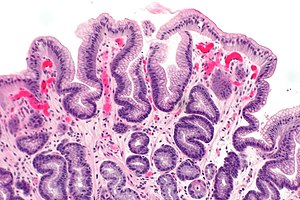Reactive gastropathy
Jump to navigation
Jump to search
Reactive gastropathy, abbreviated RG, a relatively common pathology of the stomach. It is also known as chemical gastropathy,[1] and incorrectly referred to as chemical gastritis (see below).
| Reactive gastropathy | |
|---|---|
| Diagnosis in short | |
 Reactive gastropathy. H&E stain. | |
|
| |
| Synonyms | chemical gastritis, chemical gastropathy, NSAID gastropathy (if due to a NSAID) |
|
| |
| LM | foveolar hyperplasia - esp. tortuosity of glands in the "neck" region (S shaped glands), smooth muscle hyperplasia, scant inflammatory cells, +/-edema, +/-erosions |
| LM DDx | hyperplastic polyp of the stomach, collagenous gastritis, amyloidosis, chronic gastritis |
| Site | stomach |
|
| |
| Associated Dx | osteoarthritis (treated with NSAIDs) |
| Clinical history | classically NSAID use or alcohol use |
| Endoscopy | erythema, +/-erosions, +/-bile reflux |
| Clin. DDx | gastritis |
| Reactive gastropathy | |
|---|---|
| External resources | |
| EHVSC | 10177 |
| Wikipedia | reactive gastropathy |
NSAID gastropathy redirect to here.
General
- May be seen in the context of a previous resection/surgical reconstruction, e.g. Billroth II.
Epidemiology
General assocations:
- Increases with age.[2]
Etologic factors - associated with:[3]
- Excess acid.
- Alcohol use (excessive).
- Bile (reflux).
- May be seen post-Bilroth II (distal gastrectomy).
- Drugs.[1]
- Iron (brown pigment on histology).
- NSAIDs - synergistic effect with corticosteroids.
Notes:
Drugs that cause erosions and/or ulcers - adapted from Genta:[1]
| Drug | Comment | Indication for Rx |
|---|---|---|
| NSAIDs | common cause | pain, reduce cardiovascular risk |
| Corticosteroids | synergistic effect with NSAIDs | rheumatologic diseases + others |
| Potassium (KCl) | common cause | renal failure |
| Bisphophonates | uncommon cause | osteoporosis |
| Ferrous sulfate | very common if symptomatic | iron deficiency anemia |
| Chloroquine | uncommon | only in the context of malaria |
| Sodium polystyrene sulfonate (Kayexalate) | rare | renal failure patients |
Relation to gastritis
- May mimic a (true) gastritis symptomatically and visually in an endoscopic examination.
- "Chemical gastritis" is misnomer. Etymologically, the -itis in gastritis, implies an inflammatory process. Chemical gastropathy is not (predominantly) an inflammatory process.
- This type of confusion is not uncommon. Steatohepatitis is another example of this; it is not a process with significant inflammation yet, confusingly, carries the -itis ending.
Gross/endoscopic
Features:[5]
- Antral erythema +/- erosions.
- +/-Bile.
Microscopic
- Foveolar hyperplasia.
- Tortuosity of glands in the "neck" region of the gastric glands.
- Associated with "mucin depletion" - cytoplasm not clear -- as is usual.
- Smooth muscle fibre hyperplasia.
- Abundant eosinophilic lamina propria.
- Scant acute & chronic inflammatory cells.
Additional features.
- +/-Edema.
- +/-Erosions.
Notes:
- Triad rarely present; mild inflammation common.
DDx:
Images
Sign out
STOMACH, BIOPSY: - ANTRAL-TYPE GASTRIC MUCOSA WITH REACTIVE GASTROPATHY, SEE COMMENT. - NEGATIVE FOR INTESTINAL METAPLASIA. - NEGATIVE FOR HELICOBACTER-LIKE ORGANISMS. - NEGATIVE FOR DYSPLASIA AND NEGATIVE FOR MALIGNANCY. COMMENT: This nonspecific finding may be due to a number of causes, including medications (especially NSAIDs), alcohol and bile reflux.
RG and mild chronic gastritis
STOMACH, BIOPSY: - ANTRAL-TYPE GASTRIC MUCOSA WITH REACTIVE GASTROPATHY AND MILD CHRONIC INACTIVE INFLAMMATION. - NEGATIVE FOR INTESTINAL METAPLASIA. - NEGATIVE FOR HELICOBACTER-LIKE ORGANISMS. - NEGATIVE FOR DYSPLASIA AND NEGATIVE FOR MALIGNANCY.
Not well-developed
STOMACH, BIOPSY: - BODY-TYPE GASTRIC MUCOSA WITHIN NORMAL LIMITS. - ANTRAL-TYPE GASTRIC MUCOSA WITH SMOOTH MUSCLE HYPERPLASIA, RARE GLAND TORTUOSITY AND NO SIGNFICANT INFLAMMATION, SEE COMMENT. - NEGATIVE FOR INTESTINAL METAPLASIA. - NEGATIVE FOR HELICOBACTER-LIKE ORGANISMS. - NEGATIVE FOR DYSPLASIA AND NEGATIVE FOR MALIGNANCY. COMMENT: These findings are suggestive of a reactive gastropathy; however, gland corkscrewing is not evident.
Not well-developed with minimal inflammation
STOMACH, BIOPSY: - ANTRAL-TYPE GASTRIC MUCOSA WITH SMOOTH MUSCLE HYPERPLASIA, RARE GLAND TORTUOSITY AND MINIMAL CHRONIC INACTIVE INFLAMMATION, SEE COMMENT. - NEGATIVE FOR INTESTINAL METAPLASIA. - NEGATIVE FOR HELICOBACTER-LIKE ORGANISMS. - NEGATIVE FOR DYSPLASIA AND NEGATIVE FOR MALIGNANCY. COMMENT: The smooth muscle hyperplasia and rare gland tortuosity are suggestive of a reactive gastropathy.
Isolated smooth muscle prominence
STOMACH, BIOPSY: - ANTRAL-TYPE GASTRIC MUCOSA WITH PROMINENT SMOOTH MUSCLE, OTHERWISE WITHIN NORMAL LIMITS. - NEGATIVE FOR INTESTINAL METAPLASIA. - NEGATIVE FOR HELICOBACTER-LIKE ORGANISMS. - NEGATIVE FOR DYSPLASIA AND NEGATIVE FOR MALIGNANCY.
See also
References
- ↑ 1.0 1.1 1.2 1.3 Genta, RM. (Nov 2005). "Differential diagnosis of reactive gastropathy.". Semin Diagn Pathol 22 (4): 273-83. PMID 16939055.
- ↑ Maguilnik, I.; Neumann, WL.; Sonnenberg, A.; Genta, RM. (Aug 2012). "Reactive gastropathy is associated with inflammatory conditions throughout the gastrointestinal tract.". Aliment Pharmacol Ther. doi:10.1111/apt.12031. PMID 22928604.
- ↑ ALS. 5 February 2009.
- ↑ Wolf, EM.; Plieschnegger, W.; Schmack, B.; Bordel, H.; Höfler, B.; Eherer, A.; Schulz, T.; Vieth, M. et al. (Dec 2014). "Evolving patterns in the diagnosis of reactive gastropathy: data from a prospective Central European multicenter study with proposal of a new histologic scoring system.". Pathol Res Pract 210 (12): 847-54. doi:10.1016/j.prp.2014.08.009. PMID 25238940.
- ↑ Iacobuzio-Donahue, Christine A.; Montgomery, Elizabeth A. (2005). Gastrointestinal and Liver Pathology: A Volume in the Foundations in Diagnostic Pathology Series (1st ed.). Churchill Livingstone. pp. 69. ISBN 978-0443066573.
- ↑ El-Zimaity. 18 October 2010.
- ↑ Iacobuzio-Donahue, Christine A.; Montgomery, Elizabeth A. (2005). Gastrointestinal and Liver Pathology: A Volume in the Foundations in Diagnostic Pathology Series (1st ed.). Churchill Livingstone. pp. 69. ISBN 978-0443066573.